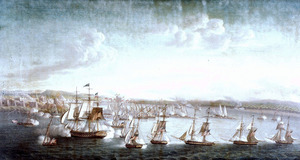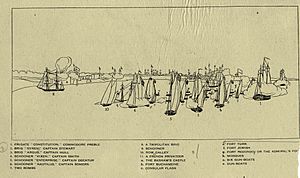USS Syren (1803) facts for kids

USS Syren (fourth from the right) during the bombardment of Tripoli in 1804.
|
|
Quick facts for kids History |
|
|---|---|
| Name | USS Syren |
| Builder | Nathaniel Hutton |
| Cost | $32,522 |
| Laid down | 1803 |
| Launched | 6 August 1803 |
| Commissioned | 1 September 1803 |
| Renamed | Siren, 1809 |
| Fate | Captured at sea, 12 July 1814 |
| Name | Siren |
| Acquired | 12 July 1814 by capture |
| Commissioned | Not commissioned |
| Fate | Not listed after 1815 |
| General characteristics | |
| Type | Brig |
| Displacement | 240 long tons (244 t) |
| Tons burthen | 298 (bm) |
| Length | 94 ft 3+1⁄2 in (28.7 m) (overall); c,75 ft 0 in (22.9 m) |
| Beam | 27 ft 0 in (8.23 m) |
| Depth of hold | 12 ft 6 in (3.81 m) |
| Propulsion | Sail |
| Complement | 120 officers and enlisted |
| Armament | 16 × 24-pounder carronades |
The USS Syren (later called Siren) was a brig, a type of sailing ship, that served in the United States Navy. She was built in Philadelphia in 1803. This ship played a role in two important conflicts: the First Barbary War and the War of 1812. In 1814, the British Navy captured her. They never officially used her as a warship. Instead, she was likely used as a lazaretto, which is a place for people to stay when they are sick. After about a year, she disappeared from records.
Contents
About the Ship
The Syren was designed by Benjamin Hutton, Jr. She was built for the Navy by Nathaniel Hutton in Philadelphia. The ship was launched on August 6, 1803. She was officially ready for service in September of that year. Lieutenant Charles Stewart was her first commander.
The Syren was smaller than another ship, the USS Argus (1803). However, both ships carried the same number of weapons. They were both built in the same year to fight in the First Barbary War.
The First Barbary War
The Syren left Philadelphia on August 27, 1803. She arrived in Gibraltar on October 1. A few weeks later, she sailed to Algiers. She carried gifts and money for the Dey of Algiers, who was the ruler there. Then, she sailed to Syracuse, Sicily, arriving in early January 1804.
The Syren's first mission was to help destroy USS Philadelphia. This was a US Navy frigate that had gotten stuck and was captured by enemy ships. The American commander, Commodore Edward Preble, wanted to destroy the Philadelphia. This would stop the enemy from using it against his fleet.
To do this, the Syren and the ketch Intrepid sailed from Syracuse. They reached Tripoli on February 7, 1804. A strong storm forced them away. They returned to Tripoli on February 16. Before the attack, some of the Syren's crew moved to the Intrepid.
On board the Intrepid, sailors from both ships worked together. Under the command of Stephen Decatur, they successfully burned the Philadelphia. Thomas Macdonough from the Syren was also part of this brave attack.
The Syren returned to Syracuse on February 19. On March 9, she and Nautilus sailed back to Tripoli. On March 21, 1804, the Syren captured an armed ship called Transfer. This ship belonged to the Pasha, the ruler of Tripoli. Lieutenant Stewart took Transfer into the US Navy. He renamed her USS Scourge. She then served with the American fleet.
The very next day, the Syren captured another ship called Madona Catapolcana. She sent this ship to Malta. The Syren continued to operate in the Mediterranean Sea. She took part in attacks on Tripoli in August and September 1804. These actions helped force the Pasha to agree to a peace treaty.
After the peace treaty was signed on June 10, 1805, the Syren stayed in the Mediterranean. She was commanded by Master Commandant John Smith. For almost a year, she helped build good relationships with other countries in the region.
The ship returned to America in May 1806. She reached the Washington Navy Yard in August. She was stored there until 1807. In 1809, she carried important messages to France. In 1809, her sailing master at the Norfolk Navy Yard was Captain John "Mad Jack" Percival. The next year, her name was officially changed to Siren.
The War of 1812
There are not many detailed records of the Siren's service during the War of 1812. However, some small news articles mentioned her.
In May 1813, a merchant ship called Pilgrim was stopped twice. First, HMS Herald boarded her, looking for the Siren. Then, the Siren boarded her, looking for the Herald. The Siren was now commanded by Lieutenant Joseph Bainbridge.
The next month, the Siren left Belize and sailed to Cuba. After three weeks of searching for a British sloop, likely the Herald, she sailed to the coast of Florida. She stopped in New Orleans before leaving on May 9, 1813. The ship did not capture any enemy vessels on this trip. She also needed repairs.
By January 1814, the Siren was in Massachusetts. She was now commanded by Lieutenant Parker. In February, she sailed with a privateer ship called Grand Turk. Not long after sailing, Parker died. Command then went to Lieutenant N.J. Nicholson.
The Siren captured at least three merchant ships off the coast of Africa. On May 28, she captured and burned the ship Barton. This ship was sailing from Africa to Liverpool. Then, on June 1, the Siren captured Adventure, also sailing from Africa to Liverpool. She took their valuable ivory cargo and then sank the ships. At some point, the Siren also captured a ship named Catherine.
On July 12, 1814, the Siren was sailing off the West African coast. She met the British ship HMS Medway. This was a very large 74-gun third rate ship of the line. The Siren was greatly outmatched. She tried to escape. After an 11-hour chase, the Medway captured her. The Siren had even thrown her guns, anchors, and boats overboard to try and go faster. During her last journey, she had captured or sunk several British merchant ships. Among the captured crew was Samuel Leech, who later wrote about his experiences.
According to Samuel Leech, the Syren's crew was taken to the Cape of Good Hope. They landed at Simonstown and were marched to a jail in Cape Town. They stayed there until they were moved to England after the war ended. In Simonstown, they saw other American prisoners leaving the jail. These prisoners were being sent to Dartmoor. The Syren crew met them again in England while waiting to return to the United States. Some of these prisoners had been present at a sad event called 'The Massacre'.
British Service
After the British Navy captured the Siren, they added a figurehead of a mermaid to her front.
The Royal Navy used her as a lazaretto. This means she was likely used to hold sick people or as a prison ship. She is not mentioned in records after 1815.


